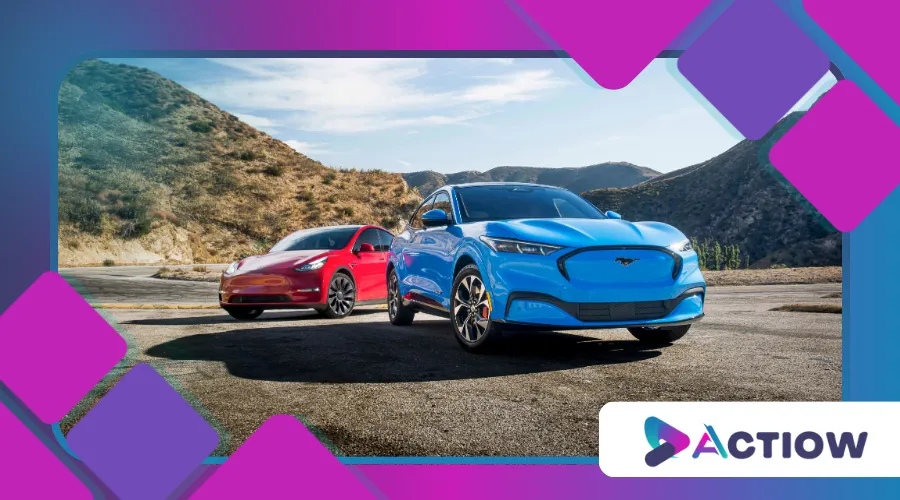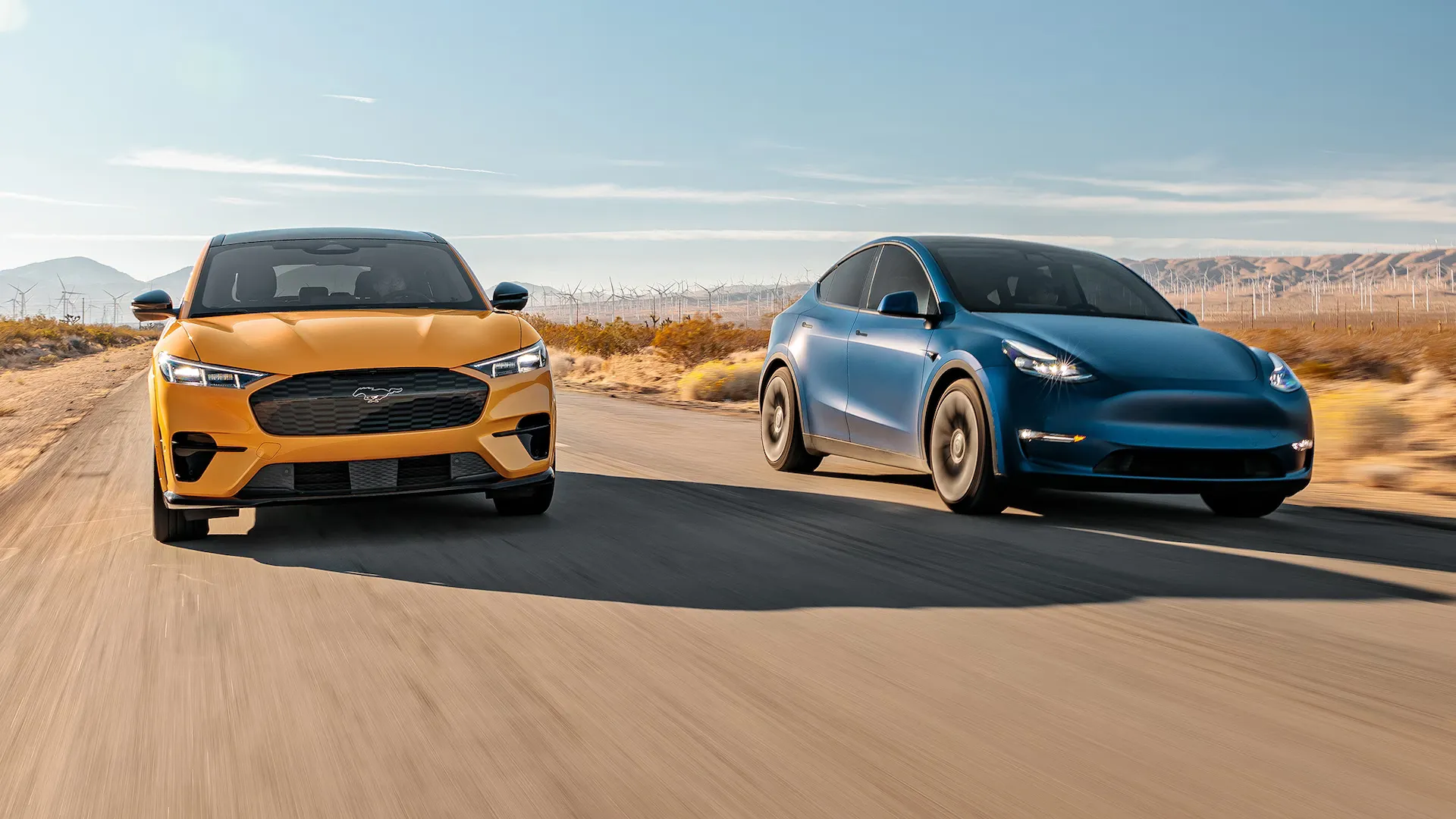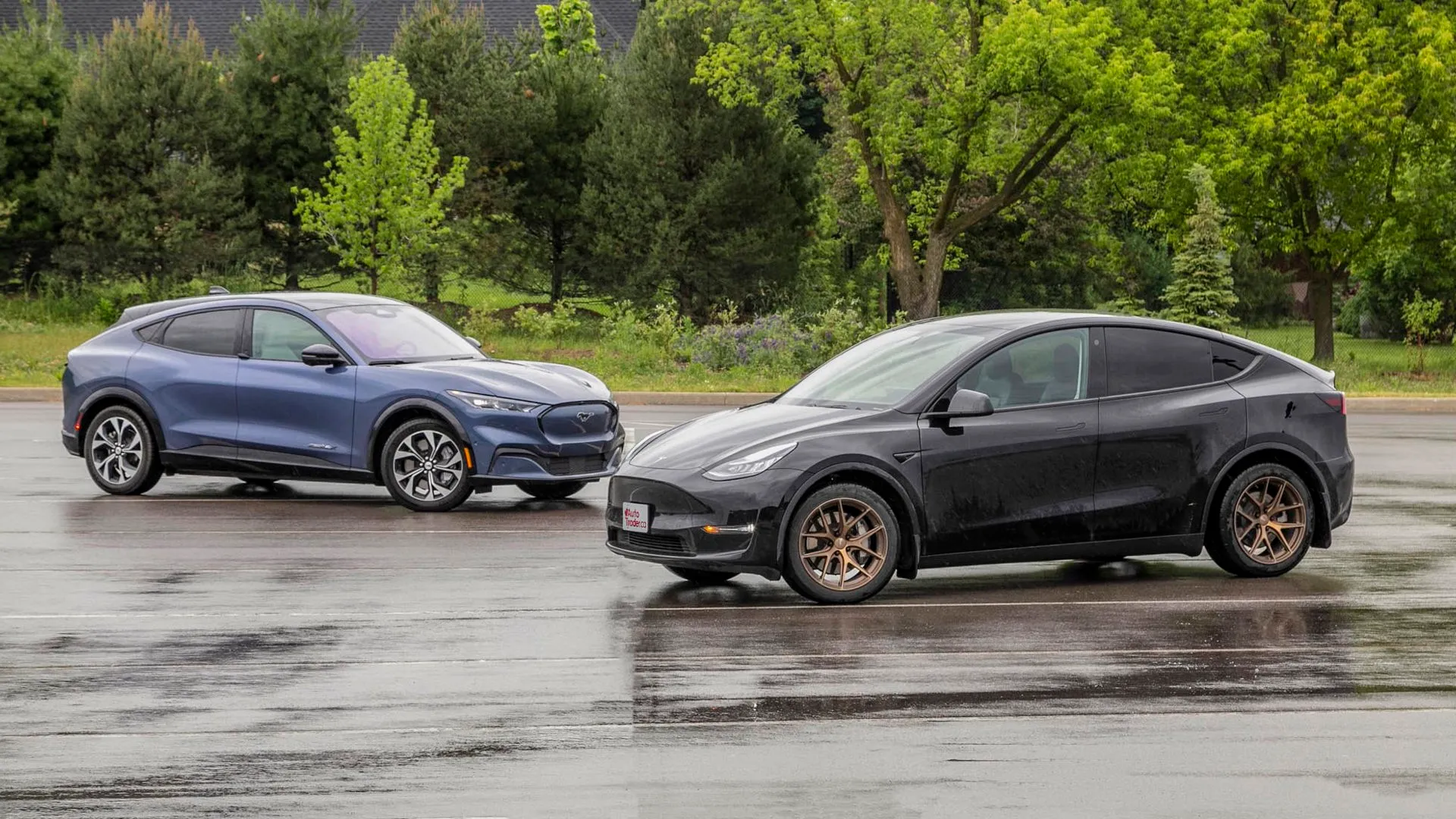Tesla Model Y vs Ford Mustang Mach-E: Electric Cars Face Off

Anúncios
The electric vehicle (EV) market is hotter than ever, and two models are stealing the spotlight: the Tesla Model Y vs Ford Mustang Mach-E.
Both vehicles represent the pinnacle of innovation, blending performance, technology, and sustainability.
But which one truly stands out?
Anúncios
In this head-to-head comparison, we’ll dive deep into their features, performance, and value to help you decide which EV deserves your driveway.
As more consumers shift towards electric mobility, the competition between these two models highlights the rapid advancements in technology and infrastructure.
With a growing emphasis on sustainability, both manufacturers are making strides to minimize their environmental impact beyond just vehicle emissions.
Design: Futuristic Elegance vs Retro-Modern Flair
When it comes to design, the Tesla Model Y and Ford Mustang Mach-E take distinctly different approaches.
The Model Y embraces Tesla’s signature minimalist aesthetic, with clean lines, a sleek silhouette, and a lack of traditional grilles.
It’s a design that screams modernity and efficiency.
On the other hand, the Mustang Mach-E pays homage to its iconic Mustang heritage while embracing an electric future.
Its muscular stance, aggressive front fascia, and tri-bar taillights give it a sporty, retro-modern vibe.
While the Model Y appeals to those who prefer understated sophistication, the Mach-E caters to drivers who want to make a bold statement.
Additionally, the choice of materials in both vehicles reflects their brand philosophies, with Tesla focusing on sustainability and Ford emphasizing performance-oriented finishes.
Ultimately, the design of each vehicle not only influences aesthetics but also affects aerodynamics and overall efficiency.
+ Toyota Corolla vs Honda Civic: Which Is the Best Sedan?
Performance: Speed, Range, and Handling
Performance is where the Tesla Model Y vs Ford Mustang Mach-E battle gets intense.
The Model Y Long Range boasts a 0-60 mph time of just 4.8 seconds and an EPA-estimated range of 330 miles, making it one of the most efficient EVs on the market.
Its dual-motor all-wheel-drive system ensures excellent traction and handling, whether you’re navigating city streets or tackling winding roads.
The Mustang Mach-E GT Performance Edition, however, is no slouch.
It rockets from 0-60 mph in a blistering 3.5 seconds, outpacing the Model Y in raw acceleration.
With a range of 270 miles, it falls short of the Tesla’s impressive numbers, but its sport-tuned suspension and rear-wheel-drive bias deliver a more engaging driving experience.
Both vehicles feature advanced regenerative braking systems, enhancing their efficiency and providing a more dynamic driving experience.
As EV technology continues to evolve, manufacturers are also focusing on improving battery management systems to optimize performance and longevity.
| Performance Comparison | Tesla Model Y Long Range | Ford Mustang Mach-E GT Performance |
|---|---|---|
| 0-60 mph Acceleration | 4.8 seconds | 3.5 seconds |
| EPA-Estimated Range | 330 miles | 270 miles |
| Drivetrain | Dual-Motor AWD | RWD/AWD |

Interior and Technology: Minimalism vs Driver-Centric Innovation
Step inside the Tesla Model Y, and you’re greeted by a futuristic cabin dominated by a 15-inch touchscreen.
The absence of physical buttons and a driver’s display may feel alien to some, but it’s a testament to Tesla’s commitment to simplicity.
The infotainment system is intuitive, and over-the-air updates ensure your car is always up-to-date with the latest features.
Moreover, the spaciousness of the Model Y’s interior enhances the overall driving experience, making it feel more like a luxury vehicle.
The Ford Mustang Mach-E takes a more traditional approach, with a 15.5-inch touchscreen complemented by a 10.2-inch digital driver’s display.
The interior feels more familiar, with physical controls for essential functions.
Ford’s SYNC 4A system is user-friendly, and the inclusion of Apple CarPlay and Android Auto is a win for those who prefer seamless smartphone integration.
Additionally, the Mach-E offers customizable ambient lighting and premium sound systems, elevating the overall driving ambiance.
Both vehicles are designed with comfort and usability in mind, catering to a wide range of driver preferences.
++ Jeep Compass vs Hyundai Creta: Which SUV to Choose for Your Next Adventure?
Charging Infrastructure: Tesla’s Supercharger Network vs Ford’s Growing Network
One of the most significant advantages of the Tesla Model Y is access to Tesla’s extensive Supercharger network.
With over 45,000 Superchargers globally, Tesla owners enjoy fast, reliable charging almost anywhere.
The Model Y can recharge up to 80% in just 30 minutes, making long-distance travel a breeze.
This extensive network not only enhances convenience but also builds consumer confidence in owning an EV.
The Ford Mustang Mach-E relies on the growing Electrify America network, which, while expanding, still lags behind Tesla’s infrastructure.
Ford offers complimentary charging sessions for Mach-E owners, but the network’s reliability and availability can vary.
As the demand for EVs increases, both companies are investing in expanding their charging infrastructures to meet consumer needs.
Furthermore, partnerships with other charging networks are becoming more common, allowing for greater accessibility for EV drivers.
| Charging Comparison | Tesla Model Y | Ford Mustang Mach-E |
|---|---|---|
| Charging Network | Tesla Supercharger | Electrify America |
| Charging Speed (0-80%) | ~30 minutes | ~45 minutes |
| Global Charging Stations | 45,000+ | 3,500+ |

Safety and Autonomy: Cutting-Edge vs Conservative
Tesla’s Autopilot system is a standout feature in the Model Y, offering advanced driver-assistance capabilities like adaptive cruise control, lane-keeping, and automatic lane changes.
The Full Self-Driving (FSD) package, though controversial, pushes the boundaries of autonomous driving.
With regular software updates, Tesla continually improves its safety features, ensuring that drivers benefit from the latest advancements.
On the other hand, the Ford Mustang Mach-E counters with its Co-Pilot360 suite, which includes adaptive cruise control, lane-centering, and evasive steering assist.
While it lacks Tesla’s ambitious autonomy claims, Ford’s system is reliable and focuses on enhancing safety without overpromising.
Moreover, Ford emphasizes a comprehensive approach to safety, including rigorous testing and crash safety ratings.
Both models have received high safety ratings, reflecting their commitment to protecting occupants and minimizing accidents.
Price and Value: Premium vs Competitive
The Tesla Model Y starts at $49,990 for the Long Range version, while the Ford Mustang Mach-E begins at $42,995 for the Select trim.
Both vehicles qualify for federal tax incentives, but Tesla has hit the 200,000-vehicle cap, meaning incentives may vary by state.
When it comes to value, the Model Y offers superior range and access to Tesla’s charging network, but the Mach-E’s lower starting price and engaging driving dynamics make it a compelling alternative.
In addition, potential buyers should consider the long-term savings associated with EV ownership, including lower maintenance costs and fuel expenses.
As the market evolves, manufacturers are also adjusting their pricing strategies to remain competitive and attract a broader audience.
With the rise of new models entering the EV space, consumers have more options than ever, making price and value critical factors in their decision-making process.
Conclusion: Which EV Reigns Supreme?
The Tesla Model Y vs Ford Mustang Mach-E debate ultimately comes down to priorities.
If you value cutting-edge technology, unmatched range, and a robust charging network, the Model Y is hard to beat.
However, if you crave a sportier driving experience, a more traditional interior, and a lower price point, the Mach-E is a worthy contender.
Both vehicles represent the best of what the EV market has to offer, and choosing between them is a win-win scenario.
As the EV landscape continues to evolve, one thing is clear: the future of driving is electric, and it’s more exciting than ever.
In conclusion, as consumers become more environmentally conscious, the demand for electric vehicles will only increase.
The competition between models like the Model Y and Mach-E will drive innovation, ultimately benefiting consumers and the planet alike.
Reference: According to a 2023 study by J.D. Power, Tesla’s Supercharger network is rated the most reliable and user-friendly charging infrastructure, with a satisfaction score of 734 out of 1,000, compared to Electrify America’s score of 573.
